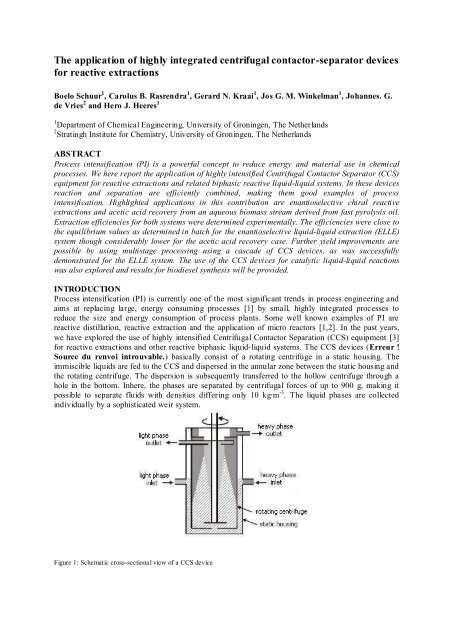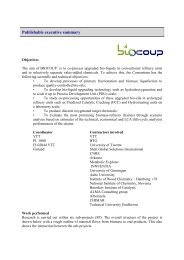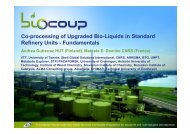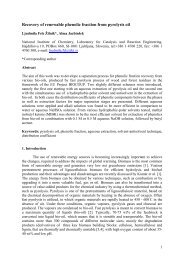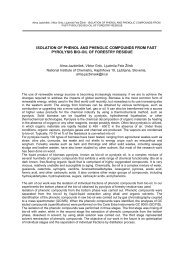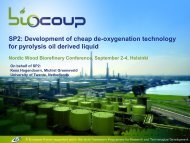The application of highly integrated centrifugal contactor ... - Biocoup
The application of highly integrated centrifugal contactor ... - Biocoup
The application of highly integrated centrifugal contactor ... - Biocoup
Create successful ePaper yourself
Turn your PDF publications into a flip-book with our unique Google optimized e-Paper software.
<strong>The</strong> <strong>application</strong> <strong>of</strong> <strong>highly</strong> <strong>integrated</strong> <strong>centrifugal</strong> <strong>contactor</strong>-separator devices<br />
for reactive extractions<br />
Boelo Schuur 1 , Carolus B. Rasrendra 1 , Gerard N. Kraai 1 , Jos G. M. Winkelman 1 , Johannes. G.<br />
de Vries 2 and Hero J. Heeres 1<br />
1 Department <strong>of</strong> Chemical Engineering, University <strong>of</strong> Groningen, <strong>The</strong> Netherlands<br />
2 Stratingh Institute for Chemistry, University <strong>of</strong> Groningen, <strong>The</strong> Netherlands<br />
ABSTRACT<br />
Process intensification (PI) is a powerful concept to reduce energy and material use in chemical<br />
processes. We here report the <strong>application</strong> <strong>of</strong> <strong>highly</strong> intensified Centrifugal Contactor Separator (CCS)<br />
equipment for reactive extractions and related biphasic reactive liquid-liquid systems. In these devices<br />
reaction and separation are efficiently combined, making them good examples <strong>of</strong> process<br />
intensification. Highlighted <strong>application</strong>s in this contribution are enantioselective chiral reactive<br />
extractions and acetic acid recovery from an aqueous biomass stream derived from fast pyrolysis oil.<br />
Extraction efficiencies for both systems were determined experimentally. <strong>The</strong> efficiencies were close to<br />
the equilibrium values as determined in batch for the enantioselective liquid-liquid extraction (ELLE)<br />
system though considerably lower for the acetic acid recovery case. Further yield improvements are<br />
possible by using multistage processing using a cascade <strong>of</strong> CCS devices, as was successfully<br />
demonstrated for the ELLE system. <strong>The</strong> use <strong>of</strong> the CCS devices for catalytic liquid-liquid reactions<br />
was also explored and results for biodiesel synthesis will be provided.<br />
INTRODUCTION<br />
Process intensification (PI) is currently one <strong>of</strong> the most significant trends in process engineering and<br />
aims at replacing large, energy consuming processes [1] by small, <strong>highly</strong> <strong>integrated</strong> processes to<br />
reduce the size and energy consumption <strong>of</strong> process plants. Some well known examples <strong>of</strong> PI are<br />
reactive distillation, reactive extraction and the <strong>application</strong> <strong>of</strong> micro reactors [1,2]. In the past years,<br />
we have explored the use <strong>of</strong> <strong>highly</strong> intensified Centrifugal Contactor Separation (CCS) equipment [3]<br />
for reactive extractions and other reactive biphasic liquid-liquid systems. <strong>The</strong> CCS devices (Erreur !<br />
Source du renvoi introuvable.) basically consist <strong>of</strong> a rotating centrifuge in a static housing. <strong>The</strong><br />
immiscible liquids are fed to the CCS and dispersed in the annular zone between the static housing and<br />
the rotating centrifuge. <strong>The</strong> dispersion is subsequently transferred to the hollow centrifuge through a<br />
hole in the bottom. Inhere, the phases are separated by <strong>centrifugal</strong> forces <strong>of</strong> up to 900 g, making it<br />
possible to separate fluids with densities differing only 10 kg·m -3 . <strong>The</strong> liquid phases are collected<br />
individually by a sophisticated weir system.<br />
Figure 1: Schematic cross-sectional view <strong>of</strong> a CCS device
<strong>The</strong> CCS was originally developed for waste water cleaning in the nuclear industry [4] and has been<br />
used successfully for oil-water separation [5] (e.g. for cleaning oils spills), for extraction <strong>of</strong><br />
fermentation broths [6] and several other extraction processes [7, 8].<br />
In this paper, we will provide two examples <strong>of</strong> the use <strong>of</strong> reactive extractions in the CCS devices. <strong>The</strong><br />
first involves ELLE <strong>of</strong> amino-acid derivatives with a chiral host in a single CCS device as well in a<br />
cascade <strong>of</strong> a number <strong>of</strong> CCS devices is series. A second example deals with acetic acid recovery by<br />
reactive extraction from an aqueous biomass feed obtained from a fast pyrolysis oil upgrading unit. In<br />
addition, the <strong>application</strong> for catalytic liquid-liquid reactions was also explored and an example for<br />
biodiesel synthesis will be provided.<br />
METHODOLOGY<br />
All continuous reactive extraction experiments were performed in a CCS from the CINC company<br />
(model V02). A schematic cross section <strong>of</strong> the CSS is depicted in Erreur ! Source du renvoi<br />
introuvable.. <strong>The</strong> CCS is equipped with a rotor (diameter <strong>of</strong> 5.04 cm) which has a maximum<br />
rotational frequency <strong>of</strong> 100 Hz (6000 rpm). <strong>The</strong> maximum total liquid throughput <strong>of</strong> the CCS is 2<br />
L/min. <strong>The</strong> CCS was operated in a once-through mode (without recycling <strong>of</strong> the liquid feeds) at<br />
ambient pressure and temperature. Detailed process conditions (flow rates, feed concentrations and<br />
rotational speeds) are given in the main text. A capillary electrophoresis (CE) system from Agilent<br />
Technologies was used to determine the amount <strong>of</strong> acetic acid in the aqueous phase. A detailed<br />
description <strong>of</strong> the CE method is described elsewhere [9]. Analytical details for the ELLE system are<br />
given in reference 10.<br />
RESULTS AND DISCUSSION<br />
Enantioselective liquid-liquid extraction (ELLE) using CCS devices<br />
ELLE is a promising and emerging technology to separate the two enantiomers <strong>of</strong> a racemate using a<br />
chiral extractant [11]. Although the technique is already known since the late 1960’s, it has to the best<br />
<strong>of</strong> our knowledge not yet been applied on larger, commercial scale. Possible reasons are the high<br />
liquid hold-up in conventional continuous extraction equipment leading to large inventories <strong>of</strong> the<br />
expensive chiral hosts and the relatively low extraction efficiencies requiring multi-stage processing.<br />
In this respect, CCS devices may bridge the gap between typical ELLE on lab scale in batch and<br />
conventional continuous processing. <strong>The</strong> devices are compact, flexible and combine a low liquid holdup<br />
with high throughput rates. We have explored [12] the use <strong>of</strong> the CCS devices for ELLE using a<br />
model system consisting <strong>of</strong> an amino-acid derivative, 3,5-dinitrobenzoyl-d,l-leucine (DNB-d,l-leu, see<br />
Figure 2, left) and a chiral cinchona alkaloid host (O-(1-t-butylcarbamoyl)-11-octadecylsulfinyl-10,11-<br />
dihydro-quinine (CA, see Figure 2 right) [13]. <strong>The</strong> DNB-d,l-leu is present in the aqueous phase and<br />
extracted by the host dissolved in an organic solvent (typically 1,2-dichloroethane).<br />
Figure 2: Chemical structures <strong>of</strong> DNB-d,l-leu (left) and extractant CA (right)<br />
<strong>The</strong> pro<strong>of</strong> <strong>of</strong> principle for the use <strong>of</strong> the CCS devices for ELLE was obtained by performing<br />
experiments with equal flow rates <strong>of</strong> both phases (F aq = F org = 30 mL min -1 ) and a rotational frequency<br />
<strong>of</strong> 50 Hz. Initially, the CINC was fed with pure 1,2-dichloroethane as organic solvent and a buffered<br />
aqueous solution <strong>of</strong> racemic DNB-d,l-leu (1 mM). After several minutes steady-state was achieved<br />
(Figure 3). Subsequently, the organic feed was switched from pure 1,2-dichloroethane to a CA<br />
solution in 1,2-dichloroethane (0.5 mM).
Y l , Y d (-)<br />
0.8<br />
0.7<br />
0.6<br />
0.5<br />
0.4<br />
0.3<br />
chemically aided<br />
extraction<br />
physical<br />
extraction<br />
0.2<br />
-10 -5 0 5 10 15 20 25 30<br />
t (min)<br />
Figure 3: Extraction pr<strong>of</strong>iles. Faq = Forg = 30 mL min -1 , N = 50 Hz, pH = 5.12, c DNB-d,l-leu,aq,0 = 1 mM, C A,org,0 = 0.5 mM. □:<br />
Y l , ○: Y d<br />
As expected, the enantiomeric excess (ee) is negligible when applying 1,2-dichloroethane without host<br />
(t < 0). At t > 0, the extraction yields <strong>of</strong> both enantiomers increase dramatically due to complexation<br />
with CA in the organic phase. Steady-state operation is achieved in less than 10 minutes. <strong>The</strong> steadystate<br />
yield <strong>of</strong> the l-enantiomer, DNB-l-leu is 0.78 and 0.53 for the d-enantiomer. Here, the yields are<br />
defined as:<br />
Y<br />
i<br />
Forg<br />
ci,<br />
org,<br />
tot<br />
[ i l,<br />
d]<br />
(eq 1)<br />
F c<br />
aq<br />
i,<br />
aq,<br />
in<br />
Furthermore, it is clear that the host has a preference for the l-enantiomer, leading to an organic phase<br />
ee <strong>of</strong> 19%. <strong>The</strong> ee in the aqueous phase is 37%. This experiment clearly illustrates the suitability <strong>of</strong> the<br />
CCS device for enantioselective liquid-liquid extraction. Further optimization studies were performed<br />
by varying relevant process conditions like input concentrations, aqueous pH, flow rates and rotational<br />
frequency <strong>of</strong> the rotor. <strong>The</strong> yield was shown to be essentially independent <strong>of</strong> the flow rates (up to 500<br />
ml/min for both F aq and F org ), indicating that the chemical compositions in the outlet, even at these<br />
high flow rates, are at equilibrium. At optimised conditions, the ee org was 34% and the l-enantiomer<br />
yield, Y l was 0.61, leading to a performance factor (PF) <strong>of</strong> 0.21. Recycle <strong>of</strong> the expensive chiral host<br />
by a backextraction step, <strong>of</strong> paramount importance for the process economy, was investigated in a<br />
single CCS device and was shown to be sufficient for efficient host recovery.<br />
To increase the extraction yields and performance factors, the chiral extraction was carried out in a<br />
countercurrently operated cascade <strong>of</strong> CCS devices including a back extraction step (Figure 4) [14].<br />
DNB-l-leu<br />
99 + % ee<br />
Single stage<br />
back-extraction<br />
BE<br />
Strip water<br />
full organic extract recycle<br />
Wash water<br />
1<br />
2 F-1 F<br />
F+1<br />
N-1<br />
Cascade with N stages for extraction<br />
N<br />
DNB-d-leu<br />
99 + % ee<br />
Racemic<br />
aqueous feed<br />
Figure 4: Schematic representation <strong>of</strong> a countercurrent setup <strong>of</strong> N CCS devices for separation <strong>of</strong> a racemate into its<br />
enantiomers with full recycle <strong>of</strong> the extract stream
extraction efficiency, E (%)<br />
Experiments in a cascade <strong>of</strong> six CCS devices for the extraction steps and one for the back extraction<br />
were performed successfully. For a 6 h run, the average ee <strong>of</strong> the l-enantiomer was 98% [15].<br />
Recovery <strong>of</strong> organic acids from aqueous pyrolysis oil streams<br />
A very promising and versatile technology for lignocellulosic biomass valorization to bi<strong>of</strong>uels and<br />
biobased chemicals is fast pyrolysis. <strong>The</strong> process yields a liquid product, known as fast pyrolysis oil or<br />
bio-oil, in high yields [16]. Pyrolysis oil is a complex mixture comprising <strong>of</strong> oxygenated organic<br />
compounds belonging to various organic groups (carboxylic acids, alcohols, ketones, aldehydes and<br />
sugars) and water [17]. Our interest concerns the recovery <strong>of</strong> high valued added value chemicals from<br />
fast pyrolysis oil. This study reports our activities aimed to isolate organic acids from fast pyrolysis oil<br />
with an emphasis on acetic acid. Acetic acid is the major organic acid in pyrolysis oil with<br />
concentrations up to 10 wt%, depending on the feedstock and process conditions applied in the<br />
pyrolysis process [18]. Acetic acid is an important industrial commodity chemical with a total<br />
production <strong>of</strong> 6.94 million tons in 2009. One <strong>of</strong> the possible isolation routes for acetic acid involves<br />
separation <strong>of</strong> the oil in an organic and a water fraction. This is possible by the addition <strong>of</strong> water to the<br />
pyrolysis oil, leading to phase separation and the formation <strong>of</strong> an oil and aqueous phase. <strong>The</strong> oil phase<br />
may be upgraded and used as a co-feedstock in a standard refinery [19] or as a liquid transportation<br />
fuel [16]. <strong>The</strong> water phase is enriched in acetic acid and is a very suitable feed for a reactive liquidliquid<br />
extraction process using a long chain aliphatic tertiary amine in a suitable diluent.<br />
Exploratory batch experiments with a typical waterphase (3.3 wt% <strong>of</strong> acetic acid) showed highest<br />
equilibrium extraction efficiencies (86%) for acetic acid when using a reactive extraction system<br />
consisting <strong>of</strong> tri-n-octylamine (TOA) in 2-ethyl-hexanol (40 wt%) at room temperature.<br />
<strong>The</strong> continuous reactive extraction <strong>of</strong> the aqueous phase in the CCS device was also investigated. <strong>The</strong><br />
aqueous and organic flow rates (TOA dissolved in 2-ethyl-hexanol, 40 wt%) were both set at 30<br />
ml/min. Experiments were carried out at room temperature with a rotor frequency <strong>of</strong> 50 Hz. To avoid<br />
emulsion formation in the CCS device [20], the low shear option was investigated. This involves the<br />
use <strong>of</strong> an insert in the annular zone which prevents direct contact between the liquids in the annular<br />
zone and the rotor. <strong>The</strong> experiment was run for 1.25 h in a once through mode and a total <strong>of</strong> 2.25 L <strong>of</strong><br />
organic phase was collected. <strong>The</strong> results are depicted in<br />
Figure 5. <strong>The</strong> extraction efficiency, η E (eq 2), increased between 0-15 minutes and was about constant<br />
throughout the remaining run time. This implies that steady state operation in the CCS device was<br />
achieved after about 15 minutes.<br />
100<br />
90<br />
80<br />
70<br />
0 15 30 45 60 75<br />
100<br />
90<br />
80<br />
70<br />
60<br />
50<br />
40<br />
30<br />
20<br />
10<br />
60<br />
50<br />
40<br />
30<br />
20<br />
10<br />
0<br />
0<br />
0 15 30 45 60 75<br />
t (min)
Figure 5: Extraction efficiencies for acetic acid as a function <strong>of</strong> time in the continuous CCS device (low shear option, line for<br />
illustrative purposes only).<br />
mass<br />
aqueous outlet<br />
acetic acid <br />
1 <br />
100%<br />
(eq 2)<br />
E<br />
aqueous inlet<br />
mass<br />
<strong>of</strong> acetic acid <br />
<strong>The</strong> average extraction efficiency at steady state was 48%. This value is considerably lower than the<br />
equilibrium value obtained in the batch setup under similar conditions. Thus, equilibrium is not<br />
achieved in the CCS device at the operating conditions <strong>of</strong> these experiments. Apparently, the overall<br />
kinetics <strong>of</strong> the process are much slower than that for ELLE with the DNB-d,l-leu and CA system,<br />
where liquid throughputs up to 500 ml for each phase were possible without significant changes in the<br />
composition <strong>of</strong> the output streams. Higher reactive extraction efficiencies for the acetic acid case are<br />
likely possible by reduction <strong>of</strong> the flow rates (higher residence times) or preferably by performing the<br />
experiments in a cascade <strong>of</strong> CCS devices operated in a countercurrent mode like for the ELLE<br />
example and these are in progress.<br />
Biodiesel synthesis in CCS devices<br />
<strong>The</strong> CCS devices are also suitable for catalytic chemical reactions in liquid-liquid systems. As an<br />
example, we here provide the results <strong>of</strong> our study on the base catalysed production <strong>of</strong> biodiesel<br />
(FAME) from sunflower oil and methanol in a CCS device [21, 22]. Process parameters like catalyst<br />
loading (sodium methoxide), temperature, rotational frequency and flow rates <strong>of</strong> the feed streams were<br />
investigated and at optimized conditions, a reproducible FAME yield <strong>of</strong> 96% was achieved (feed rate<br />
<strong>of</strong> 12.6 mL. min -1 sunflower oil and a six-fold molar excess <strong>of</strong> MeOH (3.15 mL.min -1 )). <strong>The</strong> CCS<br />
device was equipped with a jacket to allow for reactions at elevated temperature (75 o C jacket<br />
temperature). <strong>The</strong> productivity under those conditions (61 kg FAME.m -3 liquid.min -1 ) was slightly<br />
higher than for a conventional batch process. <strong>The</strong> main advantage is the combined reaction-separation<br />
in the CCS, eliminating the necessity <strong>of</strong> a subsequent liquid-liquid separation step. Recent<br />
investigations have shown that further purification <strong>of</strong> the crude biodiesel with a methanol wash is also<br />
possible in a CCS, allowing the synthesis <strong>of</strong> purified biodiesel from a plantoil and methanol in two<br />
CCS devices in series, one for reaction/separation and one for biodiesel purification [23].<br />
CONCLUSIONS<br />
CCS devices are very suitable to intensify liquid-liquid reaction like reactive extractions as well as<br />
catalytic liquid-liquid reactions. This was illustrated with three examples, two on reactive extractions<br />
(ELLE to separate enantiomers and acetic acid recovery) and one for a catalytic liquid-liquid system<br />
(biodiesel synthesis). <strong>The</strong> devices allow for continuous processing, are compact, flexible and combine<br />
a low liquid hold-up with high throughput rates. Multistage extractions are possible by applying a<br />
series arrangement <strong>of</strong> CCS devices, as was experimentally demonstrated for ELLE. <strong>The</strong> devices are<br />
commercially available in a wide range <strong>of</strong> throughputs, which will facilitate further scale up and<br />
ultimate commercialisation <strong>of</strong> the processes.<br />
ACKNOWLEDGEMENTS<br />
<strong>The</strong> research on ELLE was financially supported by the Dutch Foundation for Scientific Research<br />
(NWO) through the Separation Technology program in cooperation with DSM and Organon. <strong>The</strong><br />
BIOCOUP project (EU 6th framework, contract number 518312) is acknowledged for financial<br />
support for the research activities concerning the reactive extraction <strong>of</strong> acetic acid.<br />
REFERENCES
Stanckiewicz, A., & Moulijn, J. (2004) Re-Engineering the chemical processing plant; Process Intensification, Marcel<br />
Dekker, Inc., New York. [1]<br />
Mason, B.P., Price L., Steinbacher, J.L., Bogdan A.R. & McQuade, D.T. (2007) Greener approaches to organic<br />
synthesis using microreactor technology, Chem. Rev. Vol. 107, pp. 2300-2318. [2]<br />
Meikrantz, D.H., Macaluso, L.L., Sams, H.W., Schardin, C.H. & Federici A.G., (1998) Centrifugal separator,<br />
08/779592. [3]<br />
Bernstein, G., Grosveno, D., Lenc, J.F., & Levitz, N.M. (1973) High-Capacity Annular Centrifugal Contactor, Nucl.<br />
Technol. Vol. 20, pp. 200-202. [4]<br />
Klasson, K.T., Taylor, P.A., Walker, J.F., Jones, S.A., Cummins, R.L. & Richardson S.A. (2005) Modification <strong>of</strong> a<br />
<strong>centrifugal</strong> separator for in-well oil-water separation, Sep. Sci. Technol. Vol. 40, pp. 453-462. [5]<br />
Zhou, J.Z., Duan, W.H., Zhou, X.Z. & Zhang, C.Q. (2006) Extraction <strong>of</strong> hydrocortisone from the fermentation liquor with<br />
annular <strong>centrifugal</strong> <strong>contactor</strong>s, Sep. Sci. Technol. Vol. 41, pp. 573-581. [6]<br />
Birdwell, J.F., McFarlane, J., Hunt, R.D., Luo, H., DePaoli, D.W., Schuh, D.L. & Dai, S. (2006) Separation <strong>of</strong> Ionic<br />
Liquid Dispersions in Centrifugal Solvent Extraction Contactors, Sep. Sci. Technol. Vol. 41, pp. 2205-2223. [7]<br />
Xu, J.Q., Duan, W.H., Zhou, X.Z. & Zhou, J.Z. (2006) Extraction <strong>of</strong> phenol in wastewater with annular <strong>centrifugal</strong><br />
<strong>contactor</strong>s, J. Hazard. Mater. Vol. 131, pp. 98-102. [8]<br />
Rasrendra, C.B., Makertihartha, I.G.B.N., Adisasmito, S. & Heeres H.J. (2010) Green chemicals from d-glucose:<br />
Systematic studies on catalytic effects <strong>of</strong> inorganic salts on the chemo-selectivity and yield in aqueous solutions, Top. Catal.<br />
Vol. 53, pp. 1241. [9]<br />
Schuur, B., Winkelman J.G.M. & Heeres H.J. (2008) Chiral separations: Equilibrium studies on the enantioselective<br />
liquid-liquid amino acid extraction using a cinchona alkaloid. Ind. Eng. Chem. Res. Vol. 47(24), pp. 10027. [10]<br />
Steensma, M,; Kuipers, N.J.M., de Haan, A.B.; Kwant, G. (2006) Chirality Vol. 18, pp. 314-328. [11]<br />
Schuur B. , Floure, J., Hallet, A., Winkelman, J.G.M., de Vries J.G. & Heeres H.J. (2008) Continuous chiral separation<br />
<strong>of</strong> amino acid derivatives by enantioselective liquid-liquid extraction in <strong>centrifugal</strong> <strong>contactor</strong> separators. Org. Process Res.<br />
Dev. Vol. 12(5), pp. 950 [12]<br />
Kellner, K.H., Blasch, A., Chmiel, H., Lammerh<strong>of</strong>er, M. & Lindner, W. (1997) Chirality Vol. 9, pp. 268. [13]<br />
Schuur, B., Winkelman, J.G.M., de Vries, J.G. & Heeres, H.J. (2010) Experimental and modeling studies on the enantioseparation<br />
<strong>of</strong> 3,5-dinitrobenzoyl-(R),(S)-leucine by continuous liquid-liquid extraction in a cascade <strong>of</strong> <strong>centrifugal</strong> <strong>contactor</strong><br />
separators, Chem. Eng. Sci., Vol. 65, pp. 4682 [14].<br />
Schuur, B., Hallett, A.J., Winkelman, J.G.M., de Vries, J.G. & Heeres H.J. (2009) Scalable Enantioseparation <strong>of</strong> Amino-<br />
Acid Derivatives using Continuous Liquid-Liquid extraction in a Cascade <strong>of</strong> Centrifugal Contactor Separators., Org. Proces.<br />
Res. Dev. Vol. 13, pp. 911-914 [15]<br />
Mohan, D., Pittman Jr, C.U. & Steele, P.H. (2006) Pyrolysis <strong>of</strong> wood/biomass for bio-oil: A critical review, Energ. Fuel,<br />
Vol. 20, pp. 848-889. [16]<br />
Sipilä, K., Kuoppala, E., Fagernäs, L. & Oasmaa, A. (1998) Characterization <strong>of</strong> biomass-based flash pyrolysis oils,<br />
Biomass Bioenerg., Vol. 14, pp. 103-113. [17]<br />
Mahfud, F.H., Van Geel, F., Venderbosch, R.H., & Heeres H.J. (2008) Acetic acid recovery from fast pyrolysis oil. An<br />
exploratory study on liquid-liquid reactive extraction using aliphatic tertiary amines, Sep. Sci. Technol., Vol. 43, pp. 3056-<br />
3074. [18]<br />
de Miguel Mercader, F., Groeneveld, M.J., Kersten, S.R.A., Way, N.W.J., Schaverien, C.J. & Hogendoorn J.A. (2010)<br />
Production <strong>of</strong> advanced bi<strong>of</strong>uels: Co-processing <strong>of</strong> upgraded pyrolysis oil in standard refinery units, Appl. Catal., B, Vol. 96,<br />
pp. 57-66. [19]<br />
Hirth, J., Bicker, M. & Vogel, H. (2003) Isolation <strong>of</strong> carbohydrate carboxylic acids from aqueous solutions by reactive<br />
extraction, Chem. Eng. Technol., Vol. 26, pp. 656-660. [20]<br />
Kraai, G.N., Schuur, B., van Zwol, F.H., van der Bovenkamp, H.H. & Heeres H.J. (2009) Novel <strong>highly</strong> <strong>integrated</strong><br />
biodiesel production technology in a <strong>centrifugal</strong> <strong>contactor</strong> separator device, Chem. Eng. J. Vol. 154, pp. 384-389. [21]
Kraai, G.N., van Zwol, F., Schuur, B., Heeres H.J. & de Vries J.G. (2008) Two-phase (bio)catalytic reactions in a table<br />
top <strong>centrifugal</strong> contact separator. Angew. Chem. Int. Ed. Vol. 47(21), pp. 3905-3908. [22]<br />
Manurung, R. Abduh, Y, Heeres, H.J., unpublished data. [23]


